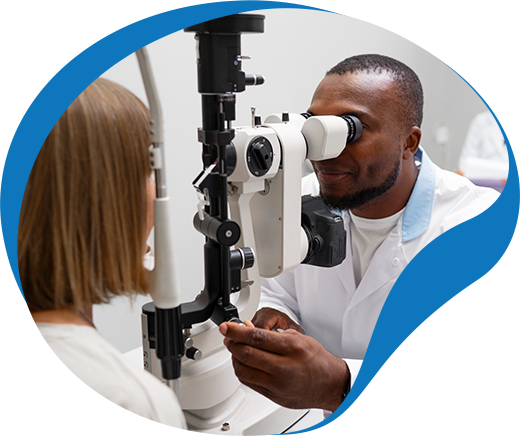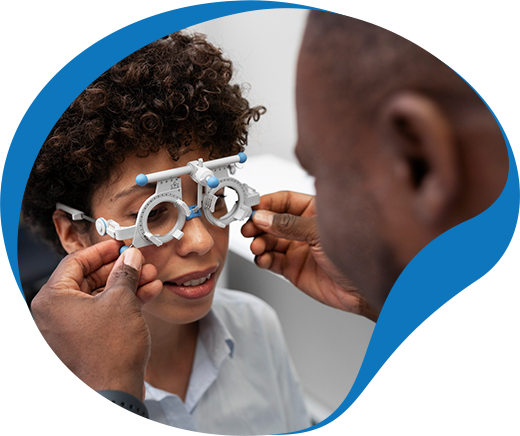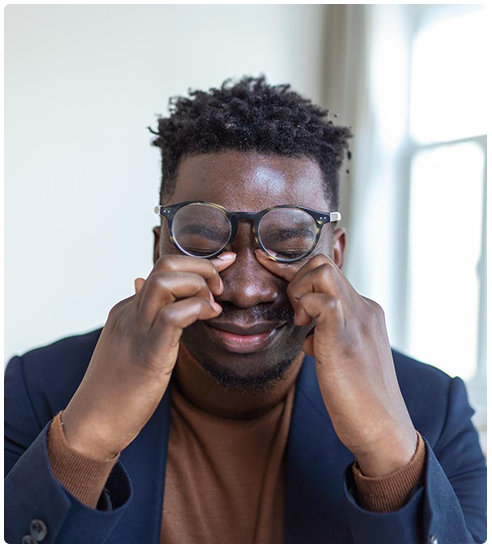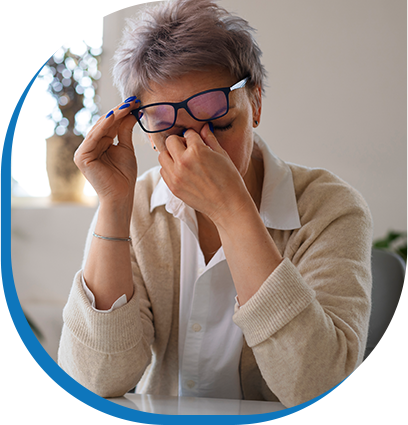HCPSC Optometrists are experts in primary and medical eye care services. They perform comprehensive eye exams for adults and children, diabetic eye exams, prescribe glasses, diagnose and manage eye diseases, and provide post-operative care for eye surgeries.
HCPSC Eye Care
The HCPSC Eye Care Team offers the following services:
Refraction & Refractive Errors
Our optometrists prescribe and fit glasses for near-sightedness (myopia), far-sightedness (hyperopia), astigmatism, and presbyopia. We see adults and children of all ages. We recommend a first eye exam at age 3 if there are no ocular symptoms such as eye turn, white pupil, or shaking eyes (nystagmus). If your child has any symptoms of an eye condition, schedule an appointment right away.

Dilated Retinal Exams
The best way to assess the eye’s health is by dilating the pupils. This allows a complete view of the retina, the inside photosensitive lining of the eye. It allows our optometrists to assess for cataracts, glaucoma, diabetic retinopathy, macular degeneration, vitreous floaters, retinal tears, retinal detachments, and many other ocular conditions. It is recommended you bring a driver with you to your eye exam to drive after you have your eyes dilated.
Pediatric Color Vision Assessment
One in five males has red/green color blindness. Color vision testing is done to diagnose potential color vision problems in children. Once diagnosed, your HCPSC Optometrist can help recommend ways to improve children’s learning despite their color vision defects.


Diabetic Retinal Screening
One of the most important aspects of managing diabetes is periodic diabetic retinal exams. This type of eye screening evaluates eye problems caused by diabetes, also known as diabetic retinopathy. If uncontrolled, this condition can lead to vision loss and blindness; therefore, diabetic patients must see their optometrists every year for regular check-ups.
At HCPSC, eye care providers have been performing these eye screenings even amidst the pandemic, particularly for high- risk patients. They use personal protective equipment to remain COVID-safe and to protect others from infection during their eye exams. As of 2023, HCPSC is now offering in-house Eye Care Services where comprehensive diabetic eye exams, including pupil dilation and pupil dilation, are being performed on all patients with pre-diabetes and diabetes.
HCPSC prides itself on providing quality healthcare services to patients, and individuals can rest assured that they will receive professional and personalized care from medical professionals in their respective fields.
Call to schedule an appointment today. 843-510-5113
Eye Care Services & Covid-19
Since viral infections have been linked with certain eye conditions in the past, scientists are trying to determine if the same may happen with COVID-19.
Recent research is examining the possible connection between COVID-19 and eye disease.
While the virus primarily affects the respiratory system, there is evidence that it can also impact other body parts, including the eyes.
There have been some reports about conjunctivitis, or pink eye, after COVID-19 in some patients.
Moreover, in the acute phase of COVID-19, some people may develop certain eye conditions, such as chemosis, epiphora, and keratoconjunctivitis. Some of these conditions are temporary and reversible, while others may cause serious damage to the vision.
Maintaining good hygiene is important to keep yourself safe from these symptoms during the pandemic, so remember to wash your hands frequently with soap and water and avoid touching your face or eyes.
Additionally, visit your optometrist if you have developed an eye condition related to COVID-19.
How Does COVID-19 Affect Eye Health?

Some viruses have the potential to cause eye problems. Coronavirus has been shown to cause:
- Conjunctivitis (pink eye)
- Ocular pain
- Dry eye
- Floaters
Conjunctivitis/COVID Eye & Epiphora
If the eye’s tear film is exposed to the virus, it may become infected and cause inflammation of the clear membrane. When caused by a virus, this condition is known as viral conjunctivitis. Symptoms include:
- Red or pink eyes
- Irritation and itching
- Inflammation and pain
- Discharge
- Watery eyes
- Photophobia (light sensitivity)

Since conjunctivitis is now considered a symptom of COVID-19, patients with this condition may be contagious. If you have tested positive for COVID-19 and are also experiencing the above symptoms, know that the tears are infected with the virus.
Therefore, it is important to maintain good eye hygiene during this time, wash your hands frequently, and avoid touching your eyes to prevent the spread of the virus.
Can COVID-19 Spread Through the Eyes?
It’s interesting to know that mouth and nose are not the only means of spreading the coronavirus. The eyes can also serve as an entry point for it.
Individuals with conjunctivitis (pink eye) can also inadvertently spread the virus when they touch their eyes and then transfer it onto a surface.
Here are a few tips to prevent the spread of the coronavirus through your eyes:
- If you wear contact lenses, switch to glasses for a few days or until you get better.
- Avoid rubbing your eyes, especially if you have symptoms of conjunctivitis.
- Wear sunglasses when going out.
- Wear goggles if you work in a healthcare facility, especially in the COVID-19 department.
Studies have also revealed that people infected through the eyes had ocular symptoms before any other typical symptoms of COVID-19. These symptoms include [9]:
- Tearing
- Redness and swelling
- Itching
- Light sensitivity
Healthcare workers are therefore advised to wear eye protection at all times when working with infected patients. Eye protection, such as goggles or face shields, can prevent the virus from entering the eyes and causing infection.
What to Do If You’re Experiencing Eye Problems With COVID-19?

While certain eye problems are associated with COVID-19, these symptoms are less common.
When you see your eye doctor, you should expect that your eyes will be assessed with a slit lamp microscope and your eyes may be dilated to assess your eye health fully.
If your eyes are uncomfortable, you can use cool compresses for relief. If you wear contact lenses, you should remove them if you have red or uncomfortable eyes. Once your eyes heal, you can wear a new pair of contact lenses.
When to See the Doctor?
While eye problems after COVID-19 may not seem like any serious issue in most cases, it’s important to consult your doctor if you experience mild eye symptoms and also have the following conditions:
Diabetic retinopathy
People with uncontrolled diabetes may suffer from an eye condition known as diabetic retinopathy. In this condition, the blood vessels in the retina can swell and bleed, sometimes resulting in progressive vision loss and blindness.
Diabetic retinopathy has become a significant public health concern in the United States as it is now the leading cause of blindness in adults [8].
If you have been diagnosed with diabetic retinopathy and you get COVID-19, you must not delay your medical visits.


Wet age-related macular degeneration (AMD)
People who have wet AMD require periodic intraocular anti-VEGF injections to protect their vision. If you have been diagnosed with wet AMD, you must not postpone your medical visit due to the pandemic.
There have been a few studies that suggest worsening of vision if these injections are missed. If the risk of coronavirus is high in your area, you can discuss postponing the injection with your ophthalmologist but don’t delay it indefinitely.
Sudden vision loss
Abrupt loss of vision during or after COVID-19 has also been classified as a dangerous symptom that you must never ignore [7]. It could be temporary but also indicate a more serious eye disease. If you experience sudden vision loss, contact your eye doctor immediately.
In addition to these, since underlying health conditions like hypertension, obesity, and asthma are more prevalent in Black and Hispanic individuals [6], these people must also take extra precautions to protect themselves from the complications of COVID-19, including ocular manifestations.


Nausea and vomiting
Nausea and vomiting are unusual symptoms of COVID-19, and they indicate a more serious complication building up. Severe vomiting and diarrhea are seen as complications of COVID-19 [7] and may require hospitalization to restore levels of electrolytes in the blood.
If eye symptoms like the ones discussed above are accompanied by vomiting and diarrhea, you must contact a healthcare professional immediately.
Children’s Eye Health and COVID-19
There has been an increase in reports of vision problems in children since the onset of the pandemic [9]. One explanation for this spike is the increased time children spend in front of the screens due to remote learning.
According to a recent survey, parents were asked to report the total screen time of their children in a day. About 70% of parents responded that their kids spend up to four hours daily on screens.
Moreover, children who already had weak eyesight before the pandemic now experience worsening vision.
Look for signs of myopia, near-sightedness or other vision problems such as:
- Blurred vision
- Squinting and blinking a lot
- Frowning while reading
- Frequent headaches

Since the cases of myopia have risen after COVID-19, you must keep a close eye on your child’s screen time and take other precautionary measures to prevent this condition.
